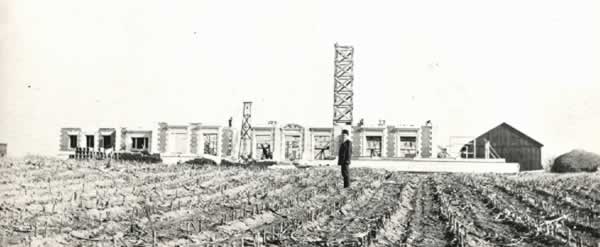Construction of the Mansion

Not looking like its going to be a 300' long, home, the O. C. Barber Mansion begins to gracefully rise from a cornfield. The Mansion, built on the highest part of the Anna Dean Farm was completed in a little over 18 months time.

Nearing completion, notice the tile stacked to the left, the Barber Mansion would be finished in time for O. C. Barber to move in on October 31, 1910. Built at a cost of over $400,000, adjusting for inflation, this would be like spending over $6 million to build a house in the 21st Century.
The Finest Mansion Between New York and Chicago
The construction of the O. C. Barber Mansion took a little longer than the construction time of the rest of the average Anna Dean Farm building. A normal building on the Farm would be completed in less than nine months. The Mansion however was no ordinary Anna Dean Farm building.
Built from March of 1909 until October of 1910, the construction would take a little over 18 months and cost over $400,000. Barn No 1, built in 1909 would cost only $8000.00 to erect and be done in less than 9 months. O. C. Barber provided all of the block and material to build the buildings on the Anna Dean Farm. The block was all cast at the O. C. Barber Concrete Company on Norton Ave. From there it was loaded on the Belt Line siding and taken to Robinson Ave. Here a crane would transfer the load to the flat bed cars pulled by a half gauge logging locomotive. The Anna Dean Farm Rail Road, would pull the block and brick from the Belt Line siding up Robinson and deliver their load to each building under construction where it would be off loaded by a boom crane. After all of the material was delivered to a particular building the tracks were pulled up and rerouted to the next building. The Mansion was no exception.
The firm of Harpster and Bliss of Akron were the Anna Dean Farm architects. The Mansion, as was all of the Farm buildings, was built in the French Renaissance style of architecture, which originated at the Beaux Arts School of Architecture in Paris. The Barber Mansion was the crowning achievement, both of Harpster and Bliss and the Anna Dean Farm.
When completed, the Mansion composed of 52 rooms, gracefully spread out on four floors, amounting to over 50,000 square feet of space. Built running from north to south, the Mansion would have normal daylight exposure both in the morning, from the east, and in the afternoon from the west. Unlike many mansion's of the Victorian and post Victorian era the Barber Mansion was never meant to be dark and forbidding, but very light and bright on the inside from the natural sunlight. Upon its completion in 1910 the New York Times was quoted as saying, the Barber Mansion was "the finest mansion between New York and Chicago." It truly was.
The marble for the Barber Mansion was mined in Sienna Italy. The famous
Sienna marble quarry was where Michaelangelo had mined the marble used
in his restoration of the Vatican and all of his statuary. The wood work
in the Mansion was of the finest oaks and circadian walnut. The Ballroom
in the Mansion had a teakwood parquet floor, laid in a herring bone pattern.
The ceiling in the Living Room Library was gold leaf, as was the tile
in the bathrooms. A working elevator with a glass sky light serviced all
four floors. Simply put, the O. C. Barber Mansion, was the finest mansion
between New York and Chicago.
For a virtual tour of the O. C. Barber Mansion click on the area you would like to visit.